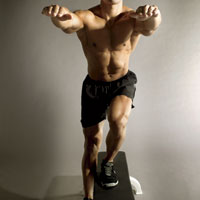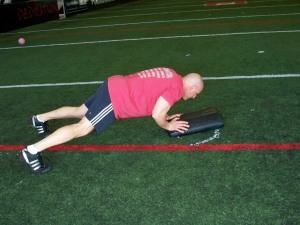
By Alwyn Cosgrove
As a trainer, I’ve witnessed some amazing things in the gym, most of which involved 300-pound powerlifters moving weight equal to that of a small SUV. (There was also the adult-film star I trained who had an orgasm every time she did hanging leg raises, but that’s another story.)
The most impressive feat I’ve ever seen, though, came courtesy of a 160-pound guy named Steve Cotter. Steve’s a martial artist, and one day he did a dozen single-leg squats while holding an 88-pound kettlebell in each hand. If that doesn’t sound particularly jaw-dropping, try doing one — without any weights.
And there lies an important point: Despite the plethora of gym equipment available, some of the greatest exercises remain the ones you can do with just your body weight — for instance, the single-arm pullup and the handstand pushup. Or the lower-body version, the best leg workout to build leg strength and improve athletic performance: the full-range, rock-bottom, single-leg squat.
So, while you may not be the strongest guy in the gym, you can still turn heads by banging out a set of single-leg squats. And the attention is just a side benefit. Master this one leg workout and you’ll see gains in strength, speed, and balance. You’ll squat more weight, jump higher, and discover athletic ability you never had before. The best part: You can do it all without setting foot in a gym.
Test your best
To determine your leg workout training plan, do as many single-leg squats as you can. If you aren’t able to perform at least two repetitions flawlessly, note the spot during your descent at which you can’t control your speed of movement. This is your “breaking point” — and you’ll need to know it to complete the routine. Once you’ve finished the test, proceed to the leg workout here that most closely matches your maximum effort.
SINGLE-LEG SQUAT
Stand on a bench or box that’s about knee height. Hold your arms in front of you and flex your right ankle so your toes are higher than your heel. Keeping your torso as upright as possible, bend your left knee and slowly lower your body until your right heel lightly touches the floor. Pause for 1 second, then push yourself up. That’s one repetition.
YOUR BEST EFFORT: 0 TO 1 REPS
THE PROBLEM: Individually, your legs aren’t strong enough to support your body weight through the entire range of motion.
THE FIX: A two-pronged attack using “negatives” and “partials,” both of which help you challenge your weak spots and lower your breaking point. Do this workout once every 4 days until you can perform at least two single-leg squats with perfect form.
Step 1
NEGATIVE SQUAT
Stand on your left leg, facing away from a bench. Holding your arms and your right leg in the air in front of you, slowly lower your body until your butt is slightly higher than your breaking point. (Ideally, this should take 5 to 7 seconds.) Sit, then stand up using both legs. That’s one repetition. Do six reps with your left leg, then six more with your right. Complete a set. Rest for 2 to 3 minutes and move on to step 2.
PARTIAL SQUAT
Stand on a bench holding a pair of 5-pound dumbbells. As you perform a single-leg squat, simultaneously lift the dumbbells in front of you to shoulder height. (This helps counterbalance your body, making the movement easier.) Again, lower your body until you’re just above your breaking point, then pause for 2 seconds before pushing yourself back up. Do 10 repetitions with each leg, pausing for 10 seconds instead of 2 on the last rep with each.
YOUR BEST EFFORT: 2 TO 5 REPS
THE PROBLEM: Because you can’t adjust the weight you’re using, as you can with free weights, your muscles give out quickly — and that limits the total number of repetitions you can perform, a key factor in increasing strength.
THE FIX: A technique called escalating density training, or EDT. Popularized by Charles Staley, author of Muscle Logic, this method helps you slow the onset of fatigue, so you can complete more total repetitions than usual. Instead of doing as many reps as you can in each set, you’ll do more sets of fewer repetitions. In addition, you’ll further increase the challenge to your legs by adding two other single-leg exercises: the Bulgarian split squat and the high stepup.
Step 1
Determine your starting point
Take the number of single-leg squats you can complete with perfect form and divide it by two. That’s how many repetitions you’ll do each set. (If your best effort is three, round down to one.) Perform the 4-week EDT routine below once every 4 days, doing the number of sets indicated and resting after each for the prescribed amount of time.
Step 2
BULGARIAN SPLIT SQUAT
Stand with a bench about 2 feet behind you and place the instep of your right foot on the bench. Keeping your torso upright, lower your body until your left thigh is parallel to the floor. Your left lower leg should remain perpendicular to the floor. Pause, then push yourself back to the starting position as quickly as you can. Do 12 to 15 repetitions, then repeat, this time with your left foot resting on the bench and your right foot in front. After you’ve worked both legs, immediately (without resting) complete step 3.
Step 3
HIGH STEPUP
Stand facing a bench or step that’s about knee height. Lift your left foot and place it firmly on the bench, push down with your left heel, and push your body upward until your left leg is straight and your right foot hangs off the bench. Lower yourself back down. That’s one rep. Do 12 to 15, then do the same number of reps with your right leg.
YOUR BEST EFFORT: 6 TO 9 REPS
THE PROBLEM: You have poor endurance.
THE FIX: Training your muscles to resist fatigue. Perform the following routine once every 4 days for 5 weeks.
Step 1
Do as many single-leg squats as you can, then rest for 60 seconds
Step 2
Repeat until you’ve completed twice the number of reps you achieved in your first set.
So, if you do seven reps in your first set, you’ll do as many sets as needed to complete 14 reps. For each subsequent workout, this will be your repetition goal.
Step 3
Each workout, try to reach your repetition goal in fewer sets. For instance, if you need five sets in your first workout, aim for your goal in four sets in your next session. After 5 weeks, repeat the entire process. But in order to keep improving, do the exercise while holding dumbbells at your sides.
Get Strong! Stay Strong!
Chris









